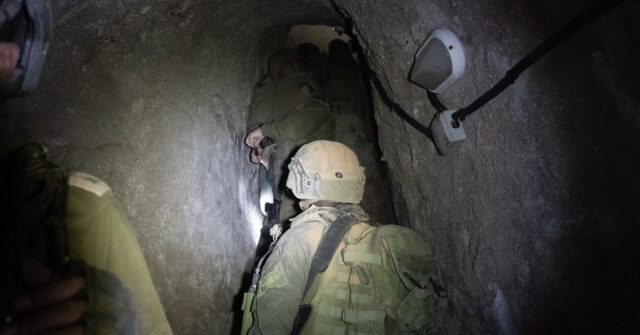The Israel Defense Forces (IDF) recently released footage and images of a substantial underground tunnel and bunker utilized by Hezbollah’s elite Radwan force, discovered beneath a Shia village in southern Lebanon. This operation was part of ongoing efforts by the IDF’s 8th Brigade combat team, which is presently engaged in targeted raids using precise intelligence to locate and dismantle such military infrastructure in the region. The intelligence-led operation revealed an extensive compound measuring approximately 800 meters, which served as a command center for Hezbollah. Inside, the IDF uncovered an alarming cache of military assets, including helicopter-fired missiles, mortar shells, motorcycles, and living accommodations, suggesting a significant operational capacity intended for provocative actions against Israel.
Hezbollah’s strategic plan, dubbed “Conquer the Galilee,” appears to be a premeditated ambition to infiltrate and conduct attacks within Israeli territory, particularly towards areas such as Kiryat Shemona and other vulnerable positions. The IDF has indicated that the presence of these weapons and the clandestine nature of their operations, notably the location of the command center embedded within a civilian area, signify a deliberate intention to escalate conflict in the region. This unearthing of the Hezbollah compound underscores the ongoing tensions between Israel and Hezbollah, prevalent since the latter is deemed a terrorist organization by Israel and other nations, leading to sporadic confrontations and ongoing military readiness on both sides.
During the raid, Israeli troops encountered a terrorist who was entrenched within the compound, which further highlighted the risks associated with these targeted operations. The engagement was guided by the support of the Israeli Air Force, resulting in the elimination of the identified threat. Following this successful operation, IDF forces continued to investigate the tunnel network’s route and functionality, indicating a commitment to dismantling Hezbollah’s military capabilities systematically. The operation illustrates the IDF’s intelligence-gathering capabilities and the seriousness with which they regard the potential for cross-border attacks.
Comparatively, Hezbollah’s tunnel systems differ significantly from those of Hamas in the Gaza Strip, both in design and operational purpose. Hamas tunnels tend to feature arched roofs, designed primarily for transporting personnel and materials undetected beneath urbanized areas. In contrast, Hezbollah’s tunnels are constructed as more robust rectangular structures, incorporating multiple underground compartments for soldiers and materiel storage. This difference in architectural design reflects their tactical requirements and operational frameworks, emphasizing Hezbollah’s long-standing military capabilities and preparation for conflict with Israel.
The emergence of Hezbollah’s military plans has been accentuated in recent weeks, as Israel has ramped up its military presence and operations in response to rising tensions in the region. The discovery of the underground bunker and its intended use as a base for aggression against Israeli towns point to the increasingly precarious security dynamics in southern Lebanon. This situation comes on the heels of Israel’s deployment of ground troops into the region, prompting a series of confrontations as both sides brace for potential escalations. The unfolding conflict continues to be characterized by a complex array of strategic maneuvers involving both state and non-state actors vying for territorial influence and security.
The information disseminated by the IDF also serves to draw public and international attention to the methods employed by Hezbollah, stressing the group’s reliance on asymmetrical warfare tactics and its willingness to operate beneath civilian infrastructures. As international observers monitor the situation, the implications of these developments extend beyond the immediate regional conflict into broader discussions on national security, counter-terrorism, and geopolitical stability in the Middle East. Given Hezbollah’s established track record of conducting attacks against Israeli interests, the IDF’s ongoing efforts to neutralize potential threats are framed as crucial to safeguarding not just Israel’s immediate borders but also its broader security strategy against non-state militant groups.

